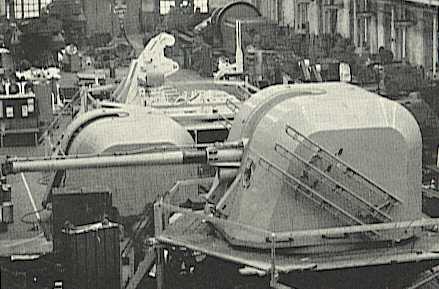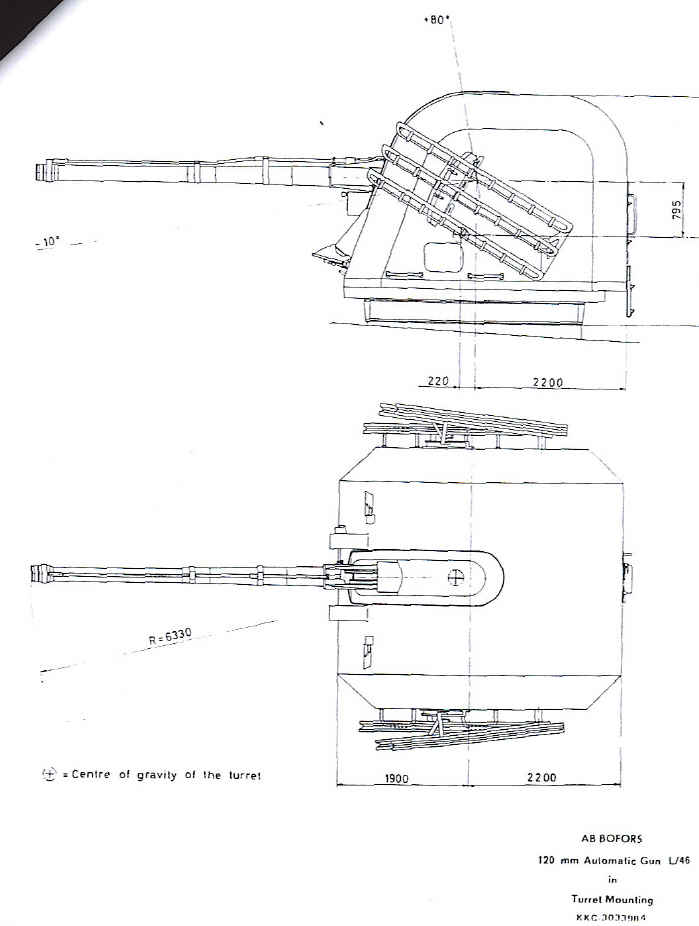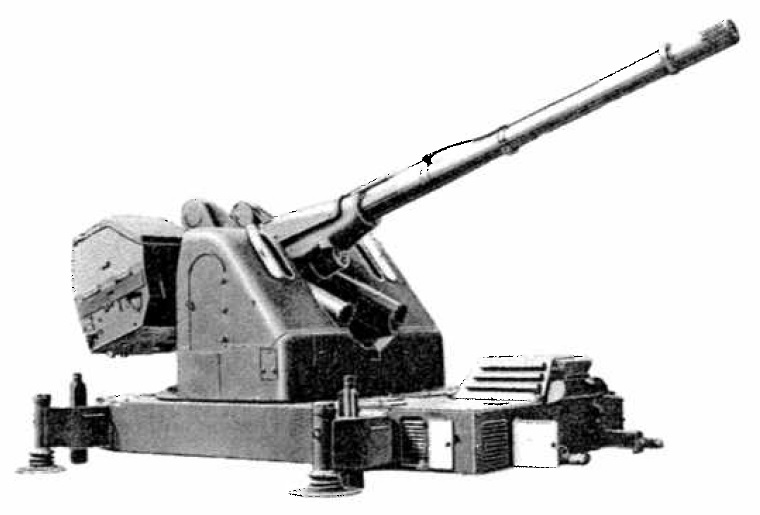A Bofors fully-automatic weapon intended for large Fast Attack Craft (FAC). Developed on a private-venture basis from the Luftvärnsautomatkanon 4501 anti-aircraft field gun.
Uses a water-cooled barrel with a replaceable liner and a vertical-sliding breech block, which opens downward during recoil. The automatic loader uses a spring-powered rammer which is cocked by the recoil forces.
"TAK" - Swedish abbreviation for Torn Automatkanon - "Turret Automatic Cannon."
| Designation | 120 mm/46 (4.7") TAK120 |
|---|---|
| Ship Class Used On | Finland: Turunmaa class and Pohjanmaa
Indonesia: Fatahilla class |
| Date Of Design | 1963 |
| Date In Service | 1967 (first prototype tested) |
| Gun Weight | N/A |
| Gun Length | 217 in (5.520 m) |
| Bore Length | N/A |
| Rifling Length | N/A |
| Grooves | 36 |
| Lands | N/A |
| Twist | Uniform RH 1 in 27 |
| Chamber Volume | N/A |
| Rate Of Fire | 80 rounds per minute cyclic |
| Type | Fixed |
|---|---|
| Weight of Complete Round | 77.1 lbs. (35 kg) |
| Projectile Types and Weights | HE: 46.3 lbs. (21 kg) |
| Bursting Charge | 6.9 lbs. (3.15 kg) |
| Projectile Length | N/A |
| Propellant Charge | N/A |
| Muzzle Velocity | 2,625 fps (800 mps) |
| Working Pressure | 16.8 tons/in2 (2,650 kg/cm2) |
| Approximate Barrel Life | N/A |
| Ammunition stowage per gun | 52 rounds in feed system 1 |
- ^This gun had a ready-use magazine on each side of the breech casing. Each breech magazine had four ammunition compartments that each held five rounds. These magazines supplied dual feed trays located on the sides of the auto loader and beneath the magazines. Each tray held six rounds, giving a total of 52 rounds in the feed system. The gun normally alternates between the two magazines but it can be fed only from one of the breech magazines, which allows two different kinds of ammunition to be used. However, it appears that only HE rounds were developed for the naval version of this gun as only one type is mentioned in the Bofors product document. In addition to the ready rounds in the feed system, there were also 16 rounds stored along the rear of the gun house as a "ready reserve" supply. More rounds were stored in a below-deck magazine, but I do not have information as to how many rounds were actually stored in the below-deck magazine for the ships that carried this weapon.
| Elevation | Distance |
|---|---|
| 45 degrees | 20,230 yards (18,500 m) |
| Distance | Time |
|---|---|
| 5,450 yards (5,000 m) | 8.0 seconds |
| 10,900 yards (10,000 m) | 21.7 seconds |
| Designation | Single Mounting
Turunmaa (1), Pohjanmaa (1) 1a and Fatahilla (1): TAK120 L/46 |
|---|---|
| Weight | 28 tons (28.5 mt) not including flare rails and ammunition |
| Elevation | -10 / +80 degrees |
| Elevation Rate | 32 degrees per second, acceleration 40 degrees per second squared |
| Train | unlimited |
| Train Rate | 40 degrees per second, acceleration 50 degrees per second squared |
| Gun recoil | 18.5 in (47 cm) nominal |
| Loading Angle | +80 degrees 2a |
- ^Pohjanmaa had this gun removed during modernization in 1996-98. It was replaced with a Bofors 57 mm.
- ^Rounds in feed system could be fired at any elevation but the feed system could only be reloaded when gun was at +80 degrees elevation. The below-deck magazines were connected to the gun house by a rod hoist. A simple tool was provided for the ammunition handlers to remove the rounds from the hoist and place them manually in the breech magazines. The hoist started automatically when a round was placed in the bottom of the hoist when the upper hoist position was empty and the gun was in the loading position. Hoist required 2.5 seconds to lift round from bottom to top of hoist.
- Turret shield was made of 0.16 in (4 mm) thin steel that was intended primarily for environmental protection but did provide some limited protection from shell fragments. Mount was gyro-stabilized and operated from three-phase 440 Vac/60 Hz power and required a maximum supply of 157 kW when accelerating at full speed. There are three rails on each side of the mount for Bofors 103 mm flare rockets. A machinery compartment was located below the rotating gunhouse and this held the traversing motor, hydraulic unit, oil cooler and central electrical panel. The turret was connected to the ship's ventilation system and normally a slight overpressure is maintained in the gunhouse and machinery compartment.
- Mounting was designed such that all ready rounds could be fired by a single crewmember. Crew consisted of operator and two ammunition loaders when in remote (automatic) operation with the addition of a layer and a sight setter when firing in local control. A "sight setting-box" was provided for setting tangent elevation and lateral deflection when in local control. Additional crewmembers were required in the below-deck magazines.
"Jane's Pocket Book 9: Naval Armament" edited by Denis Archer
"The Naval Institute Guide to World Naval Weapon Systems 1991/92" by Norman Friedman
"Jane's Fighting Ships, 1999-2000" edited by Capt. Richard Sharpe RN
---
"120 mm Automatic Gun L/46 on Field Carriage" by Bofors
"120 mm Automatic Gun L/46 in Turret Mounting" by Bofors
---
Special help from Leo Fischer
18 November 2006 - Benchmark
13 April 2011 - Updated ammunition system information, added time of flight and mounting notes
03 March 2015 - Added additional information sketch for land mounting
29 September 2023 - Converted to HTML 5 format



